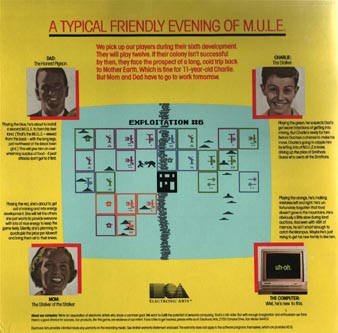

There are three versions of M.U.L.E.: Beginner's, Standard and Tournament. Each version has slightly different rules.
The player who has the most points a the end of the game is the winner.
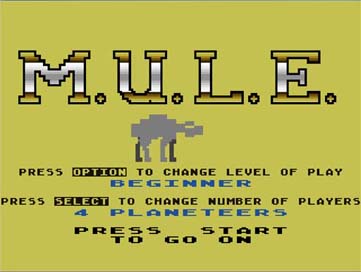
If You Want to Start Playing Right Away
The fastest way to learn is to play the Beginner's game. The next pages of this Guide have screen shots and quick-reading captions to teach you the Beginner's game FAST.
If you have any questions, read the Questions and Answers section.
The rest of this Guide has rules and strategies for the Standard and Tournament version.
Pausing the Game
To pause the game, see your Command Summary for the proper pause key. To start again, hit the space bar a second time. This is especially useful for playing and trying to read this Guide at the same time.
1. Choosing Your Character
BONZOID SPHEROID
FLAPPER
LEGGITE HUMANOID
The computer will cycle through 4 different colors. Whoever pushes his joystick button first uses that color throughout the game.
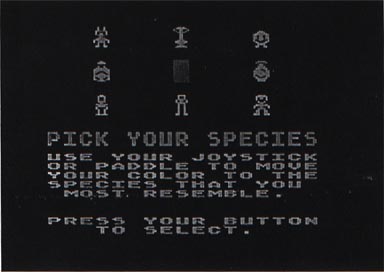
After choosing a color, you will select your character. Point the joystick towards a character, and it will appear in the center of the screen. Push your joystick button to choose it. If you don't want this one, move another character into the center of the screen, and push the joystick button. When you are done, the computer will cycle through the remaining colors for the other players.
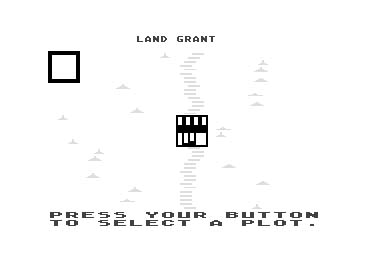
The Land Grant is your chance to get one free plot each turn.
When the moving square is over the plot you want, push your joystick button. The plot will be highlighted in your color.
Your plot of land will flash when it is your turn. Decide what you want to do with your land. Mountains are best for mining Smithore, river land is best for farming for Food and flat land is best for producing Energy.
When you push your button, the town zooms into view. Go into the corral, get a M.U.L.E., and take him to any outfitting shop.
When the time bar runs out, your turn ends regardless of what you are doing.
To install a M.U.L.E., lead him out of town to your plot of land. Push your joystick button when your character is directly over the house. If you miss you'll hear a beep. Try again.
When installed, your M.U.L.E. turns into a production symbol. Your property is ready to produce Food, Energy, or Smithore.

The Wampus lives in caves in the mountains. When he opens his door, his bell rings and a light flashes. If you catch him, he will pay you to let him go.
To catch the Wampus you have to be outside of town, without a M.U.L.E. Then, when you see his light, jump on him.
Good hunting!
Production happens automatically; you just watch your land produce. Each little box that appears on the left side of your land represents one unit.
It starts out with 16 units of Food, 16 units of Energy and no Smithore.
After that, the number of units it has to sell depends on what the players buy and sell.
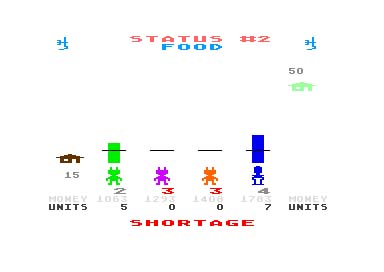
Each auction starts by showing your "Status" in that good. A line grows and
shrinks to show how much you started with, how much you used, how much
spoiled, and how much you produced during you last turn.
A
"critical line" tells you if you have a shortage or a surplus for your next
turn. (Except for Smithore which is not "critical for survival.)
Push your joystick up or down to declare whether you are a Seller or a Buyer. You can change back and forth as often as you wish until the Declare timer runs out.
Hint: If you have a surplus, you should sell it (your character will automatically jump to the SELL position). If you have a shortage, BUY!
The auction starts with the sellers on the top of the screen and the buyers on the bottom. Now the units row shows the number of units traded during the auction, instead of the number of units owned by each player.
Sellers move down to lower their prices. Buyers move up to raise their bids.
Dashed lines indicate the highest bid and the lowest price among all four players. All characters can move at the same time, racing to buy and sell before the auction timer runs out.
When the Buy Line and the Sell Line meet, the Buyer and the Seller start flashing. Trading begins, one unit at a time. As trades are made, the Buyer's money decreases, the Seller's money increases, and player's Units Traded increase.
Either player can stop trading at any time, simply by moving away from the line. Otherwise trading continues until the Seller runs out of extra product, or the Buyer runs out of money.
The Summary Report shows your points, or "Net Worth," after each round. Don't feel bad if you're in last place now. The losing player gets some advantages.
For instance, if you and another player both try to get the same piece of land during the Land Grant, you will get the land. And if you and another player both try to Buy or Sell at the same price, you will get to make the trade, even if he or she is also on the trading line.
To transfer a M.U.L.E., go to your plot (with or without a M.U.L.E. in tow).
When you press your button, the M.U.L.E. you are leading (if any) will be installed and the one previously installed will be following you. You can take the new M.U.L.E. to another plot or you can re-outfit him for a different type of production (by taking him back to town). If you have no other use for the M.U.L.E., return it to the corral for $100.
A: It may be because you and another player are both pushing your joystick buttons at the same time, and he or she is getting the land. That happens because the computer figures out who has the least amount of money, land and goods and gives that player the land. Or else it is because your "trigger finger" is just a little too slow.
Q: Why can't I watch the computer player installing a M.U.L.E.? Is it cheating on me?
A: Since computers never make mistakes, they are boring to watch. But since the don't have any imagination, the can't catch a Wampus either.
Q: Sometimes I go into the Corral and can't get a M.U.L.E. Why not?
A: You have to go all the way into the Corral. When you do, you will see the M.U.L.E. following obediently behind you. The same goes for the outfitting shops. You have to go all the way in and come all the way out.
Q: My M.U.L.E. keeps running away. What can I do?
A: M.U.L.E.s don't really like working. If they get a chance, they will run off. If your time runs out before you get your M.U.L.E. properly installed, it will scoot. If you realize you don't have enough time to lead your M.U.L.E. all the way to your land, you can return it to the corral and get your money back.
Q: Why can't I catch the Wampus?
A: Three reasons: you may be pushing your joystick button, which keeps him away; you may be standing on his mountain, which keeps him from opening his door; or maybe you aren't really cut out to be a Wampus hunter.
Q: I get to the Buy Line just as fast as another Seller and I don't get to sell anything; what's going on?
A: Remember, the player with the least amount of money, land and goods always gets the advantage. If you are richer than the other Seller, he or she will win all the "ties." The same goes when you and another player are both trying to buy something.
Q: Yes, but can't I sell just one unit?
A: Once a trade begins, no other players can break into it. Your only hope is to get one of the players to stop trading.
Q: The Store was out of Food and I still wanted to buy some. But I couldn't quite reach the Seller. Is something wrong?
A. Nope. If the Seller doesn't want to sell you anything, he or she can just stay on the top of the screen and you can't reach.
Q: How come I can't always go as high as I want to in the Auction?
A: You can't bid if you don't have enough money.
Q: Why do I have to stop selling just because I reach my "critical level?" I could have sold Food when I didn't need it for my next turn.
A: It sounds like you're ready for the Standard Game.
Prices are set by supply and demand. Prices go up when the supply is small and the demand is high; they go down when there is a large supply and little demand. For example, if there are 25 units of Smithore in the store and all the players are producing it, the store will offer a very low price to buy it.
In M.U.L.E., the store sets prices using a formula based on principles of supply and demand, and also on the latest prices paid for the product. No store price can go over $265. Food, Energy and Smithore have minimum prices of $15, $10, $14.
Economies of Scale
The "law" of Economies of Scale says that the bigger you are, the better you get. If you double the size of your operation, you more than double your effectiveness. This is because of things like mass production, and volume discounts on buying raw materials and building tools.
In M.U.L.E., if you have two or more plots of land side by side, doing the same kind of production, your M.U.L.E.s become more efficient, and average one extra unit of production on each plot.
Learning Curve Theory of Production
In many industries, as you build more and more of a product you learn how to do it more efficiently. The "Learning Curve Theory" says that every time you double the total number of units you have ever built, you "learn" to build that product for 20% less. This is the reason that calculators and computers keep costing less and less every year.
In M.U.L.E., you get an extra unit (on each plot) for every 3 plots of land you have that are all producing the same kind of product, regardless of where they are located. This is in addition to the bonus you get from economies of scale you get from adjacent plots.
For example, if you had 3 Smithore mines, and 2 were side by side, each mine would produce one extra unit for the Learning Curve effect, and the 2 adjacent plots would each produce a second extra unit for the Economies of Scale effect.
Diminishing Returns
Just when you thought you had it wired, economics comes through with the "law" of diminishing returns. This law says that economies of scale and learning curve effects reach a point where they get less and less important.
In M.U.L.E., you can see how this works if you try to develop a Smithore monopoly. At first you get high levels of production by locating mines in the mountains (where there are rich Smithore deposits), and getting the economics bonuses as well. Eventually you have to start mining for Smithore in the flat land to increase your economies of scale and learning curve effects. Sooner or later you reach a point where you get more value from giving up the economic bonuses and producing Food or Energy instead.
The Prisoner's Dilemma
Normally, in a free enterprise system, things work out best if everyone looks out for himself. However there are some cases in economics such as "The Prisoner's Dilemma," where everyone loses if each person spends too much time worrying about himself.
In M.U.L.E., if the colony doesn't survive, everyone loses. If one player is really doing poorly, he can't afford to pay high prices to buy all the Energy or Food that you are producing.
If you want a real challenge, try playing the Humanoid character against three computer players and see if you can get a total colony score of more than 100,000. If you can, we'd like to hear about it. Good luck!
First, the Standard game last 12 turns. Second, the entire colony must have a total worth of at least $60,000, or you will all get sent home to work in a M.U.L.E. factory. Here are the other changes.
Land Auction
In the Standard game, the store auctions land immediately after each Land Grant. The number of plots auctioned each turn averages 1, but can vary from 0 to 6. The plot to be auctioned will be displayed by a black flashing square. After all the players press their joystick buttons, the auction begins. To bid, simply move your character up the screen above the minimum price shown. Your bid will change as you move just as it does in other auctions. When the timer runs out, the player with the highest bid (above the minimum) receives the plot. If no player moves above the minimum bid, the plot doesn't sell. The plot will be valued at $500 in figuring your net worth during the Summary no matter how much you pay in the Auction.
Selling Land
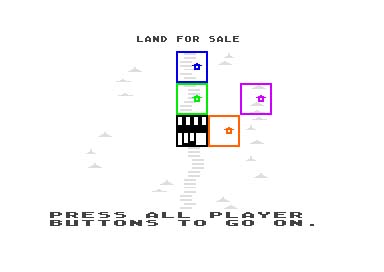
In the Standard game you can sell your land. If it sells, you receive all the money paid for it. If the plot doesn't sell, it will not be auctioned again unless you offer it again.
To mark your land "For Sale," enter the land office without a M.U.L.E., and then go to the plot you wish to sell. When you are in the center of the plot, push your joystick button and return to the land office. To help you, the timer is turned off when you enter the land office to mark a plot. Land marked "For Sale" will be offered in the Land Auction the next turn.
Selling land works differently the selling goods. When the Seller moves his joystick up and down to raise or lower the asking price, the price changes but the Seller doesn't move on the screen.
The Seller can change his asking price at any time. If he does this, if he moves the asking price either up or down, the Buyer's bid is automatically rejected, and he has to move above the asking price again. When time runs out the Buyer who is highest, and above the asking price, gets to buy the land.
There is no maximum price.
Development

In the Standard game the price of M.U.L.E.s varies from turn to turn depending on the number of M.U.L.E.s available and the number of undeveloped plots owned by players.
Each game starts with 16 M.U.L.E.s in the corral. When these are gone, then can only be replaced in one way: by building more from Smithore. It takes two units of Smithore to build a M.U.L.E., and only the store knows how. Because of the difficulty, it takes the Store an entire turn to build a M.U.L.E. from the Smithore it buys. Needless to say the prices of M.U.L.E.s and Smithore skyrocket when the colony begins to run short of M.U.L.E.s.
Another change in the Standard game: the M.U.L.E. will run away when you try to install him on your land, unless your character is directly over the house when you push your joystick button. Pushing the joystick button anyplace other than your plot will also cause the M.U.L.E. to run away.
Auction
Two changes have been made to the Auction phase. First, you can use your own judgment and sell products below your "Critical Level" if you think it is wise.
Second, when the store has no units, the selling price for a unit of any product may go as high as Buyers are willing to bid. In other words, if one player really wants something, you can make him pay for it. Because the screen is only so big, it may look as if the buyer isn't moving, when his bid price is actually rising fast; so watch the bid price. So long as the seller does not move down from the tops of the screen, no transactions are made, no matter how high the bid goes.
This allows shrewd players to take advantage of their friends.
One odd visual effect occurs if one player is bidding very high while
other players stop raising their bids: the bidder doesn't seem to move anywhere
and the non-bidders seem to be going backwards. The reason: it's all relative.
The non-bidders last bid doesn't change, only their relative positions on the
screen.
Crystite
Crystite, which is found underground, is the fourth product available for discovery and development. Crystite varies with underground contours, rather than terrain type like other products.
In each game, there are always 3 plots which each have a base production of 3 units. These centers are surrounded by plots with base production of 2 and 1. Crystite cannot be mined in the river valley, because the boggy land makes mining impossible.
There are two ways to discover Crystite. You can install a Crystite M.U.L.E. on your plot, and hope you have made a good guess, or you can take an "assay" first.
To do this, enter the assay office in town, then visit the plot you wish to check. When you are in the center of the plot, push your joystick button to obtain a soil sample. When you take the sample back to the assay office, it will report Low (1), Medium (2), High (3), or No (0) Crystite deposits on the plot.
You may take soil samples on any plot on the map, even those that no one owns yet. However, it might be tough to find the center of a plot that isn't owned, because you won't be able to see the shape of the plot. Keep trying. You'll get it sooner or later.
Collusion
You agree to Collude in a private trade so the leading player can't buy your Food.
Collusion is a powerful technique that allows players to make private deals. When collusion is in effect in an Auction, only the players involved can trade and the others are shut out. Although the basic approach is the same, Collusion works differently in Product Auctions than in Land Auctions.
To start a Collusion during a Product Auction, two or more players push their joystick buttons at exactly the same time. (To make sure that the timing is perfect, you may even have one person push BOTH the joystick buttons.) This starts a special Collusion timer, changes the color of the screen to pink, and causes the other players and the Store to fade into the background. Until time runs out, the players involved can concentrate on working out a deal between themselves. The game returns to the regular auction after collusion is over.
"Collusion works differently in the Land Auction."
The Seller gets to set the price and select the Buyer, No prearranged signal or special timing is necessary. Here's how it's done:
First, the Seller pushes his or her joystick button to begin the Collusion timer. The Buyer on the left will be highlighted and the others will fade into the background. That Buyer is the only one who can make a bid on your land. To select another Buyer, simply push your joystick button to select the next one on the right. Whoever you select can move his bid up or down, while you, at the same time, raise or lower your price. (Notice that the house does not move on the screen, but the price changes nevertheless.) A soon as the Buyer meets your price, he or she gets the land. If [the] Collusion timer runs out before anyone meets your asking price, the game returns to the normal Auction.
Don't forget: if the Buyer you select isn't going to meet your price, you can
always shut him off and "activate" another Buyer.
When I am bidding in a land auction I use a little "rule of thumb" to determine how much a plot is worth. Multiply the number of turns left by 100 and add 500. This will give you the maximum bid you should make on any piece of property. In other words, bid high for land early in the game, even though you don't have much cash; but don't get sucked into a bidding battle later in the game just because you have lots of money.
If you want to get really sophisticated, figure out what product you will
develop on the land, then figure out how many units you'll average, and how much
it will sell for. Multiply that by the number of turns left and add it to 500.
This is how the computer player figures the value of each plot of land. But if
you're like me, you won't be able to complete the full calculation before the
auction is over.
It seems I need more than my share of property (11 plots) to win. So I try to get as much land as I can. Even so, I try to get adjacent plots to take advantage of economies of scale. Unless food prices are high (over $100), I try to convert all my Food M.U.L.E.s to Smithore or Crystite by the tenth turn. I also try to stockpile energy by then so I can convert my Energy M.U.L.E.s too.
If I am behind, I always ask for advice. The suggestions don't always help, but they are usually good for a few chuckles that keep me interested.
Finally, a few short tips
Unless I capture a decisive advantage early in the game, I usually find myself in a dangerously vulnerable position. The I have to use all my wits and cunning just to survive. I can often appeal to Alan's sympathetic nature and convince him to sell me one or two units of a need commodity, but all I ever hear from Dan or Bill is something like, "You want it, let's see that price up to $300." Totally ruthless.
One bit of advice: if you just happen to find yourself in a winning position, and in possession of the only surplus Energy in the colony, pause for just a moment to remember all those times when the other players have helped you out; reflect on all those times that they showed pity on you and kept you alive; think about the good of the entire colony... and then, DON'T SELL.
As the game begins, get into Smithore. Grab a mountain plot next to the river, and mumble about the need for Food production. Usually that will convince two of the others to buy river land an develop Food.
Then don't sell Smithore to the store. You want demand to go up and the store's supply to go down. When the others start to notice, coast another turn by cursing your joystick for "inadvertently" flopping you to a Buyer when you were trying to be a Seller. By the next turn, they'll start selling all their Smithore to keep the price down. Play possum. Wait until they're almost to the store and then step a dollar above the store price and buy all the Smithore that you can. The cat's out now, and everyone is on to you.
So next turn -- don't develop at all -- let M.U.L.E.s free. Grab one, outfit it for food, step out of the town and push your button. If you're quick you can set at least four free. Smithore's price should jump to over $200. You just acquired leverage. Sell all your Smithore at the next auction.
And remember, there are drawbacks to being the winning player -- you always lose ties in the auction. So, if you and another player both need Food or Energy, and you're winning, you must be conniving. Right before the auction starts, turn to him and make a chuckle like you just made a mistake. Make strong eye-contact and start explaining. By the time he realizes that the auction has started, you'll have that little jump. So buy all the product you need, and, for good measure, buy up any that he needed, too.
![]() Food determines the amount of time you have during
Development. Average production for food in the River Valley is 4, in the
Flatlands 2, and in Mountains 1. Food prices range from $15 to $250. The
outfitting cost for a food producing M.U.L.E. is $25.
Food determines the amount of time you have during
Development. Average production for food in the River Valley is 4, in the
Flatlands 2, and in Mountains 1. Food prices range from $15 to $250. The
outfitting cost for a food producing M.U.L.E. is $25.
![]() Energy is used in the production of all products except
Energy itself. The amount you need is based on the number of non-energy plots
with M.U.L.E.s plus 1. Average production of Energy in the Flatlands is 3, in
the River Valley is 2, and in Mountains 1. Energy prices range from $10 to $250.
The outfitting cost for an energy producing M.U.L.E. is $50.
Energy is used in the production of all products except
Energy itself. The amount you need is based on the number of non-energy plots
with M.U.L.E.s plus 1. Average production of Energy in the Flatlands is 3, in
the River Valley is 2, and in Mountains 1. Energy prices range from $10 to $250.
The outfitting cost for an energy producing M.U.L.E. is $50.
![]() Smithore is used in the production of M.U.L.E.s in
the Standard and Tournament games. The store will produce 1 M.U.L.E. for every 2
Smithore units it buys from players. Average production of Smithore in the
Flatlands is 1, in the River Valley is 0, (you may not mine Crystite or Smithore
in the River Valley), and in the Mountains 1 plus the number of mountain symbols
in your plot (1 to 3 mountain symbols). In the Beginner's game Smithore has a
fixed price of $50. In other games Smithore prices range from $25 to $250. The
outfitting cost for a Smithore producing M.U.L.E. is $75.
Smithore is used in the production of M.U.L.E.s in
the Standard and Tournament games. The store will produce 1 M.U.L.E. for every 2
Smithore units it buys from players. Average production of Smithore in the
Flatlands is 1, in the River Valley is 0, (you may not mine Crystite or Smithore
in the River Valley), and in the Mountains 1 plus the number of mountain symbols
in your plot (1 to 3 mountain symbols). In the Beginner's game Smithore has a
fixed price of $50. In other games Smithore prices range from $25 to $250. The
outfitting cost for a Smithore producing M.U.L.E. is $75.
![]() Crystite can only be found when playing the
Tournament game. All Crystite found is shipped off planet. Please refer to the
Tournament game instructions for the locations of Crystite. Crystite prices
range from $50 to $150. The outfitting cost for a Crystite producing M.U.L.E. is
$100.
Crystite can only be found when playing the
Tournament game. All Crystite found is shipped off planet. Please refer to the
Tournament game instructions for the locations of Crystite. Crystite prices
range from $50 to $150. The outfitting cost for a Crystite producing M.U.L.E. is
$100.
To Start -- Note: push any joystick button to skip the opening cartoon.
F3 -- To select Beginner, Standard or Tournament version.
F5 -- To change the number of human players from 0 to 4. (If it is 0 humans, the computer plays a demonstration game).
F7 -- To start playing.
Other Commands
F2 -- To freeze or resume game play.
F3 -- To restart the game with the same characters.
Joystick Button -- To speed up computer players.
Left Keyboard Player: "Q" key = up, "Commodore" key = down, "Q" + "Commodore" = Fire
Right Keyboard Player: "Up Arrow" key = up, "=" key = down, "Up Arrow" + "=" = Fire
To Start -- Note: push any joystick button to skip the opening cartoon.
OPTION -- To select Beginner, Standard or Tournament version.
SELECT -- To change the number of human players from 0 to 4. (If it is 0 humans, the computer plays a demonstration game).
START -- To start playing.
Other Commands
SPACE BAR -- To freeze or resume game play.
OPTION/START -- To restart the game with the same characters.
Joystick Button -- To speed up computer players.
